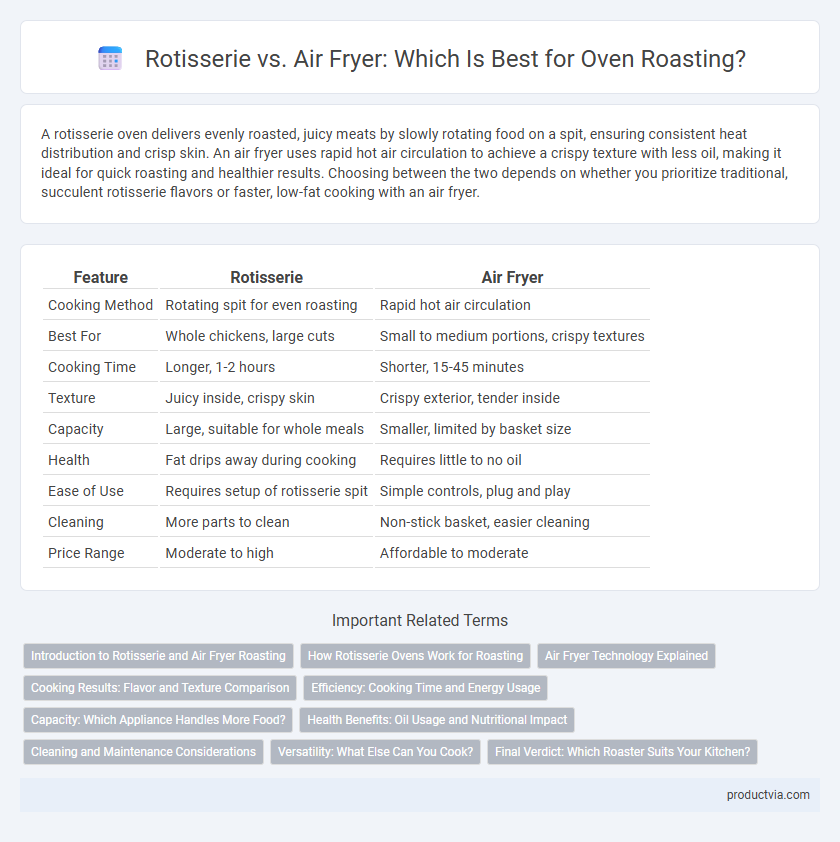A rotisserie oven delivers evenly roasted, juicy meats by slowly rotating food on a spit, ensuring consistent heat distribution and crisp skin. An air fryer uses rapid hot air circulation to achieve a crispy texture with less oil, making it ideal for quick roasting and healthier results. Choosing between the two depends on whether you prioritize traditional, succulent rotisserie flavors or faster, low-fat cooking with an air fryer.
Table of Comparison
| Feature | Rotisserie | Air Fryer |
|---|---|---|
| Cooking Method | Rotating spit for even roasting | Rapid hot air circulation |
| Best For | Whole chickens, large cuts | Small to medium portions, crispy textures |
| Cooking Time | Longer, 1-2 hours | Shorter, 15-45 minutes |
| Texture | Juicy inside, crispy skin | Crispy exterior, tender inside |
| Capacity | Large, suitable for whole meals | Smaller, limited by basket size |
| Health | Fat drips away during cooking | Requires little to no oil |
| Ease of Use | Requires setup of rotisserie spit | Simple controls, plug and play |
| Cleaning | More parts to clean | Non-stick basket, easier cleaning |
| Price Range | Moderate to high | Affordable to moderate |
Introduction to Rotisserie and Air Fryer Roasting
Rotisserie roasting uses a rotating spit inside an oven or specialized appliance to cook food evenly with self-basting juices, producing a crispy exterior and juicy interior. Air fryer roasting utilizes rapid hot air circulation to mimic deep frying, offering a healthier alternative with less oil while delivering crispy and flavorful results. Both methods enhance roasting techniques but differ in cooking mechanisms and texture outcomes.
How Rotisserie Ovens Work for Roasting
Rotisserie ovens use a rotating spit to evenly cook meat by continuously turning it over a heat source, allowing juices to baste the food naturally and produce a crispy, flavorful exterior. This constant rotation ensures uniform heat distribution, resulting in tender, succulent results ideal for roasting whole chickens or large cuts of meat. Unlike air fryers that rely on hot air circulation, rotisserie ovens combine radiant heat with rotation to achieve a distinctive roasting effect.
Air Fryer Technology Explained
Air fryer technology uses rapid air circulation to cook food evenly and create a crispy exterior with little to no oil, making it a healthier alternative to traditional roasting methods. Unlike rotisserie ovens that rely on slow, even cooking by rotating food near a heat source, air fryers achieve faster cooking times and more consistent browning through high-speed air movement. This innovative convection mechanism in air fryers enhances flavor and texture while reducing fat content compared to rotisserie roasting.
Cooking Results: Flavor and Texture Comparison
Rotisserie ovens provide even, slow roasting that enhances juiciness and imparts a rich, smoky flavor through constant rotation, ideal for whole chickens and large cuts of meat. Air fryers use rapid hot air circulation to create a crispy exterior with minimal oil, delivering a texture similar to deep frying but often lacking the deep, roasted flavor of a rotisserie. For optimal cooking results, rotisserie excels in tenderness and flavor depth, while air fryers prioritize crispiness and speed.
Efficiency: Cooking Time and Energy Usage
Rotisserie ovens typically cook larger cuts of meat evenly by rotating them slowly, resulting in longer cooking times but consistent heat distribution, while air fryers use rapid hot air circulation to cook food faster and more efficiently with less energy consumption. Air fryers generally reduce cooking time by up to 25-30% compared to rotisserie ovens, making them a more energy-efficient choice for smaller portions or quicker meals. Efficiency comparisons highlight that air fryers deliver crispy, roasted textures with lower energy usage, whereas rotisseries excel at slow, thorough roasting of whole poultry or large roasts.
Capacity: Which Appliance Handles More Food?
Rotisseries typically offer larger cooking capacities, accommodating whole chickens or multiple skewers simultaneously, making them ideal for roasting sizable meals. Air fryers, while versatile, usually have smaller baskets limiting the amount of food cooked at once, suitable for smaller portions or quick meals. For users prioritizing volume, a rotisserie often provides more space, whereas air fryers excel in efficiency for smaller batches.
Health Benefits: Oil Usage and Nutritional Impact
Rotisserie ovens typically require little to no added oil, allowing fat to drip away from the food, which reduces overall calorie content and promotes healthier roasted meals. Air fryers use rapid hot air circulation to cook food with significantly less oil compared to traditional frying, preserving nutrients while minimizing unhealthy fat intake. Both methods enhance health benefits by lowering oil consumption, but air fryers may better retain certain vitamins due to shorter cooking times.
Cleaning and Maintenance Considerations
Rotisserie ovens often require thorough cleaning of drip trays and rotating spits to prevent grease buildup, which can be time-consuming. Air fryers feature non-stick baskets and removable parts that are generally dishwasher-safe, making maintenance quicker and simpler. Regular cleaning is essential for both appliances to maintain optimal performance and extend device lifespan.
Versatility: What Else Can You Cook?
A rotisserie excels at evenly roasting meats like chicken and beef, offering precise control for slow, juicy results, while an air fryer provides versatile cooking options, including frying, baking, and reheating with less oil. Air fryers handle a wider variety of foods such as vegetables, frozen snacks, and baked goods, making them suitable for everyday use beyond roasting. Rotisseries are specialized for roasting, but air fryers combine multiple cooking functions in a compact appliance.
Final Verdict: Which Roaster Suits Your Kitchen?
Rotisserie ovens deliver evenly cooked, juicy meats by rotating food on a spit, preserving natural flavors and tenderness, ideal for traditional roasting. Air fryers use rapid hot air circulation to produce crispy textures with less oil, perfect for quick, versatile meals and healthier cooking. Choose a rotisserie for classic, succulent roasts and a rich flavor profile, while an air fryer suits kitchens seeking convenience, speed, and multi-purpose cooking functionality.
Rotisserie vs Air Fryer for roasting Infographic

 productvia.com
productvia.com